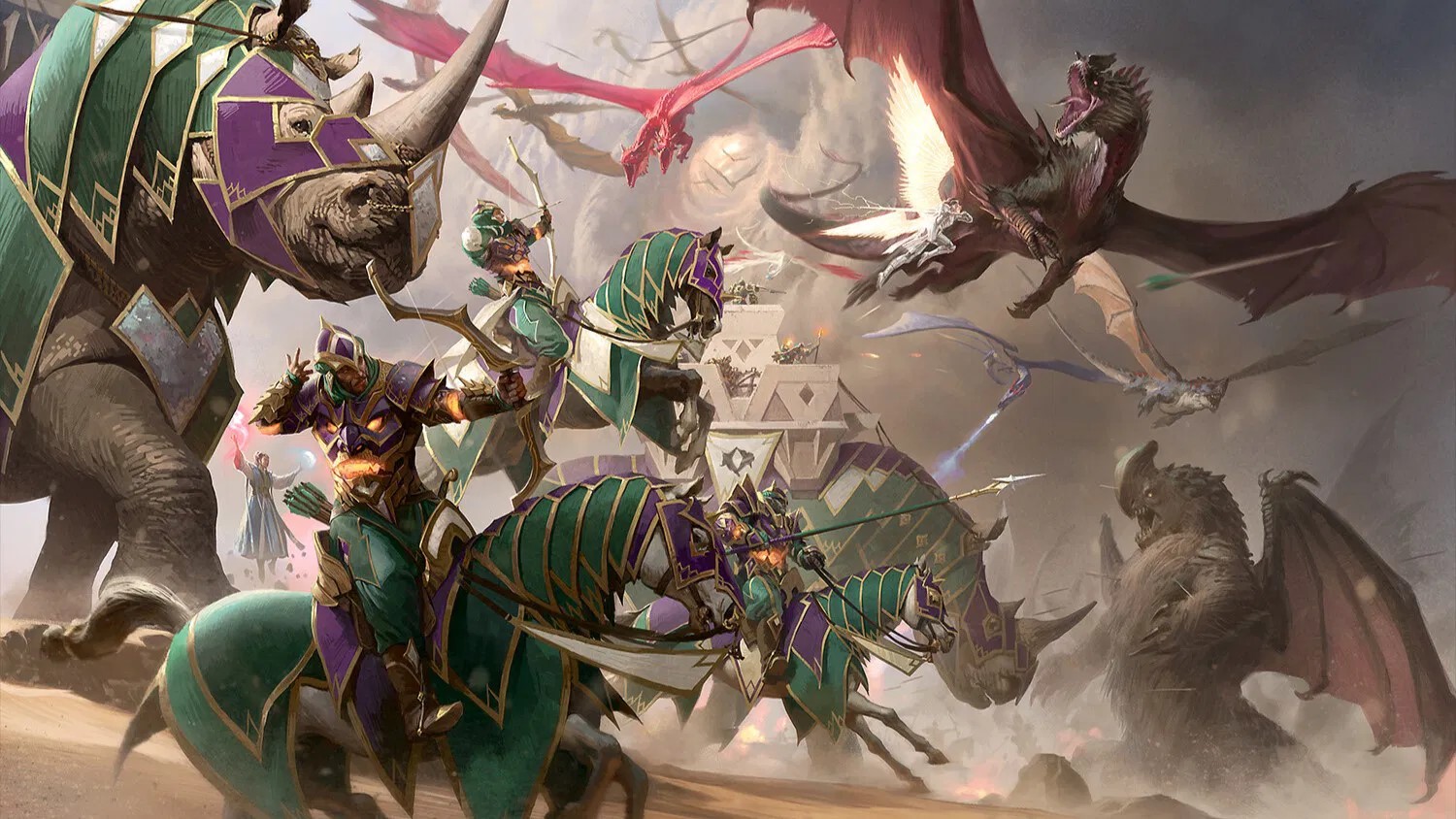Table of Contents
Pioneer is seeing some major upheaval since the start of the year, showing that players continue to innovate on competitive decks in the format. There are new decks making up the top tier alongside veritable staples, and combo decks continue to come and go. Outside of one deck, the last two sets weren't too impactful but the next one is looking much more promising.
Here's what the current Pioneer metagame looks like.
Tier List
| Tier | Deck | Meta Share |
|---|---|---|
| Tier 1 | Red Deck Wins | 18.5% |
| Izzet Phoenix | 14.5% | |
| Mono Black Demons | 10.4% | |
| Tier 2 | Selesnya Company | 8.3% |
| Azorius Control | 5.4% | |
| Jund Sacrifice | 4.4% | |
| Mono White Tokens | 3.6% | |
| Tier 3 | Izzet Prowess | 2.9% |
| Azorius Spirits | 2.6% | |
| Lotus Field Combo | 2.6% | |
| Mono Blue Helix | 2.1% | |
| Dimir Rogues | 2.1% | |
| Rakdos Demons | 1.5% |
Meta Overview
Rakdos Demons is Pioneer top dog no more. From being the most played for much of the format's life to now barely part of Tier 3, the deck has been supplanted by the Mono Black version that seems to have a more favorable game one against the other top decks in the meta.
In similar fashion, Rakdos Prowess lost a color and is now Red Deck Wins, the new most popular deck in Pioneer. It's no longer focused on pure speed but packs more punch to seal the deal even when it's initial push gets tossed.
Three white decks make up the bulk of the middle of the pack. Mono White Tokens is notable for seeing a resurgence thanks to new cards from Tarkir: Dragonstorm.
Jund Sacrifice may continue to drop down in overall popularity as its best matchups, such as Rakdos Demons, aren't a big part of the meta anymore.
Only two combo decks are a part of the report this time but there are a bunch lurking in Tier 3, like Creativity, Quintorius, and Neoform, that can rise up with some innovative deckbuilding.
Tier 1
Red Deck Wins
Red Deck Wins rose to the top of Pioneer around March this year when Rakdos Prowess players realized slamming 4 blb-155-sunspine-lynx in a non-basic land heavy format makes more sense than trying to fling enlarged mice at the opponent. The burning cat can close out games quickly once you get their life total low, and dsk-157-screaming-nemesis further shuts down life gain, which a lot of other top decks have in some form.
While not as fast as before, the current RDW iteration has a lot more staying power with its larger creatures and doesn't rely on just good prowess draws to grab the win. It lost efficient disruption from its black discard and removal sideboard cards but it can pressure life totals more effectively with otj-134-magebane-lizard and one-153-urabrasks-forge.
This deck went 9-0 in a recent Pioneer Challenge:
Izzet Phoenix
Pioneer staple Izzet Phoenix remains as popular as ever. It can race aggro decks with cheap removal and essentially a two-turn clock once it gets multiple Phoenixes in the yard. Prior to Tarkir: Dragonstorm, blb-124-artists-talent was the latest addition, making it even easier to dig for the birds and sometimes beef up late game burn.
Because it can chain several spells a turn, the deck can support tdm-103-cori-steel-cutter well enough to provide another avenue of attack that doesn't rely on the graveyard. While most still only have it in the sideboard for grindy or slow matchups, some already play with this equipment in the main.
One such example is this 8-1 deck:
Mono Black Demons
Much like the RDW deck above, Mono Black Demons seems to be the evolution of Rakdos Demons, the most popular Pioneer deck as of around 3-4 months ago. pdsk-118p-unholy-annex-ritual-chamber provides plenty enough card advantage even with minimal actual demons in the deck, so the main reasons to include red, plst-VOW-232-bloodtithe-harvester and neo-141-fable-of-the-mirror-breaker-reflection-of-kiki-jiki, is unnecessary.
Instead, the deck has the excellent anti-aggro aer-61-gifted-aetherborn along with main deck graveyard hate mid-104-graveyard-trespasser-graveyard-glutton. Going mono-color also means Sunspine Lynx isn't scary at all. isd-105-liliana-of-the-veil pressures hand size while neo-101-invoke-despair can generate a lot of value late game, and both can deal with pesky sticky creatures.
This exact same list went 8-1 in two different Challenges piloted by different players:
Tier 2
Selesnya Company
Playing honest creatures and fair Magic still works, if Selesnya Company maintaining a sizable meta share is any indication. The deck wants to ramp with mana elves into the best three-drops in white and green. With nearly half the deck consisting of creatures, dtk-177-collected-company can reliably bring out two new guys every time.
Typical versions of the deck include dsk-6-enduring-innocence for card advantage, with znr-4-archon-of-emeria and dmu-2-anointed-peacekeeper to hinder the opponent's plans. The deck we're featuring is more of a Selesnya Angels deck, maximizing its synergies to produce giant Angels and gain life along the way. It even finds room for bro-10-kaylas-reconstruction for even more company collection.
Player fives managed to go 8-1 in two back-to-back events with the same decklist:
Azorius Control
The top control deck of the format is seeing an uptick in its play rate in the last couple of months, despite Unholy Annex seeing more play, which needs war-61-narset-parter-of-veils to effectively answer. Perhaps the current RDW is a bit slower out the gates so it has more time to stabilize.
Most UW Control decks in the format employ iko-224-kaheera-the-orphanguard as a companion, though only as an extra card. It has the requisite counterspells and boardsweepers, plus planeswalkers to accumulate advantage every turn. There's no real win con aside from man lands, but getting an overwhelming board and card advantage is usually enough to make the opponent concede.
Here's a recent 8-1 Challenge winner:
Jund Sacrifice
Rakdos Cat Oven got two amazing additions from Bloomburrow that transformed the deck into its current Jund form. blb-111-scavengers-talent is an ultimate enabler that does everything the deck wants to do while blb-241-ygra-eater-of-all can loop two eld-81-cauldron-familiar to kill on the spot. The decklist has been pretty much optimized at this point, as the deck is highly synergistic and requires an ample number of sac outlets and targets to go off.
Jund Sacrifice is one of those combo-style decks that demand high levels of familiarity from the pilot. So much of its card interactions require managing triggers and the backup plan of pinging the opponent down with war-204-mayhem-devil needs careful math. It would be very surprising to see its meta share rise when other more straightforward options are available.
This player managed 8-1 and 7-2 finishes in two events with the same main deck (only changed snc-206-ob-nixilis-the-adversary into m21-96-duress in the sideboard):
Mono White Tokens
Three new cards from Tarkir: Dragonstorm has given the white control deck a serious boost, bumping its popularity into the highest it's been in a while. The white Collected Company tdm-32-united-battlefront is powerful enough to build the deck entirely around it, with lots of impactful low-cost enchantments. tdm-11-elspeth-storm-slayer is a no-brainer when it comes to a token-loving deck, while tdm-33-voice-of-victory comes out of the sideboard for control matchups.
On paper the deck looks great against aggro decks and has the tools to dig for answers, such as kld-5-authority-of-the-consuls versus Izzet Phoenix, despite being an 80-card deck thanks to iko-232-yorion-sky-nomad. Plus, white has a deep selection of sideboard options to improve its percentages even more.
Last weekend two players finished 1st and 2nd at a 160-player Pioneer Qualifier with nearly identical main decks:

